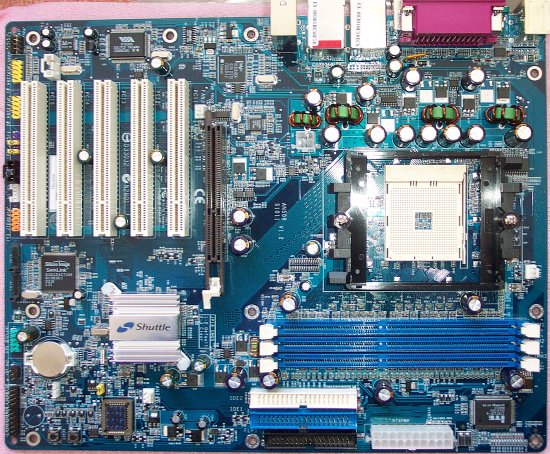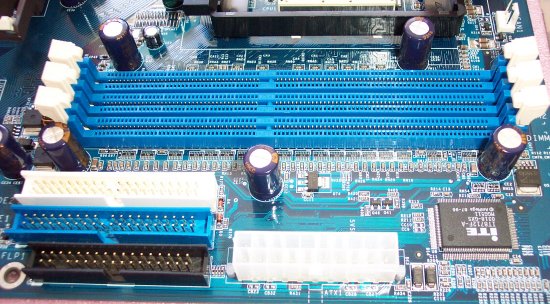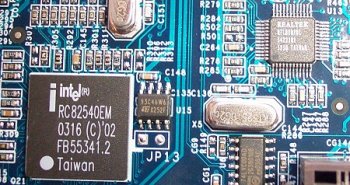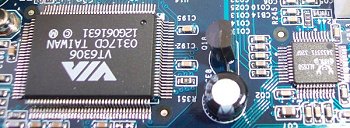Shuttle AN50R (nForce3) Layout
NVIDIA's nForce2 was universally acclaimed as a feature-rich high-performance Socket A chipset. It's now falls upon us to discern if the nForce3 150 can match or better its predecessor.

The nForce3 150 drops the Pro naming structure in Socket-754 form. Apart from that, it appears to be architecturally identical to its Socket-940 brother. The ubiquitous North Bridge is immediately conspicuous by its absence, and the all-new Socket-754 retention bracket fills the right-hand side of the board. Shuttle uses a very similar securing plate on the back of the board, and there's plenty of room around the socket. The absence of a North Bridge leaves a lot of PCB space bare, save for the tracks that link the single-chip MCP3 to the CPU, via AMD's Hypertransport link. Shuttle opts for a 4-phase PWM (Pulse Width Modulation) for delivering balanced power to the CPU. Sharing the load should help it deliver cleaner, consistent power than a traditional 3-phase design.

Whereas the VIA board had a couple of DIMM slots, Shuttle incorporate three into this nForce3 150 design, giving a potential 3GB of system memory. It bears repeating that standard, unbuffered memory can be used in single-channel mode. 3GB may be the potential limit, but the realistic limit is a more reasonable 1.5GB split over three 512MB DRAM modules. Because the AGP slot is so far down the board DDR RAM can be installed / removed without any hindrance whatsoever. Also bear in mind that AMD's Clawhammer CPU will generally even out the performance differences between differing core logics. Perhaps the largest factor in differentiating present logics is in the quality of their memory controller(s). As we saw with the performance transformation between the beleaguered VIA KT266 and impressive KT266A, an efficient memory controller is paramount to success. AMD takes away most of the interpretation here with its on-die controller and associated DRAM controller.
The 12v 4-pin power connector is located next to the large retention bracket. The standard 20-pin power connector sits on the side of the board that we like. Its location eliminates airflow problems perpetuated by numerous power cables in the middle of a board. The floppy, primary and secondary IDE ports are also located sensibly. It's a slight shame that there's only a single fan header on the CPU side of the board.


The all-singing, all-dancing nForce3 150; well, not quite. Shuttle wisely chooses to add a heatsink on the 0.15-micron chip. The transition to a single-chip design has necessitated the dropping of a few key features. As mentioned, out goes the wonderful NVIDIA APU, FireWire support and DualNet. In comes 8x AGP support and very little else. I'm not sure if our readers will share this sentiment but the nForce3 150 feels as if it's been extremely rushed, as if AMD caught NVIDIA on the hop. Computing is characterised with progression from one year to the next. We, the consumers, expect to get more each for our money in every passing year. Whether that's the case here is highly debatable.
SATA support is all the rage now, and a number of chipsets integrated controllers in their respective South Bridges. The nForce3 150 is bereft of such support so Shuttle charges Silicon Image with providing a PCI-based SATA controller. The Sil3112A 2-port controller has been around the block a few times in its young life. It's seen on boards from almost every conceivable manufacturer.. The 2 ports afford independent, RAID0 and RAID1 support. Pre-OS drivers are provided as standard. There's plenty of space around the clear CMOS jumper. That's important for enthusiasts who continually tamper with their systems in the hope of getting free performance. Shuttle also incorporates the excellent on-board on/off - reset buttons.


A number of manufacturers are now seeing fit to add Gigabit Ethernet to consumer boards. We speculate that's do with the price attractiveness of a new breed of 10/100/1000Mbit/s controllers. In this case, it's an Intel RC8254OEM Gigabit Ethernet chip. Shuttle adds another Ethernet port via the use of the on-chip NVIDIA MAC and Realtek 8201BL physical layer. Dual LAN ports are now becoming increasingly common on midrange boards. The networking possibilities of two LANs makes setting up a home network an easy task. FireWire's been removed from the chipset. VIA, of all companies, provides the 3-port single-chip FireWire controller. A couple of the three possible ports are located just below and the third is integrated into the I/O panel. Realtek's ALC650 AC'97 CODEC provides basic 6-channel sound capability, acting as a conduit for the AC'97 sound. We'd love an quality on-board hardware-accelerated sound chip. Our minds wander to the Envy24.

Optical S/PDIF-Out is a nice touch. 4 USB2.0 and a single FireWire 1394a port give lots of high-speed connectivity options. Dual LAN, if run at maximum speed, is sure to tax the PCI bus. Shuttle has attempted to gloss over the deficiencies present in the single-chip nForce3 150 design by adding a number of discrete controllers. This is the way that most will have to go. A good job, with respect to layout and features, from an underspecced chipset design. 3 usable fan headers allow for decent cooling without having to go running off to a MOLEX connector.









